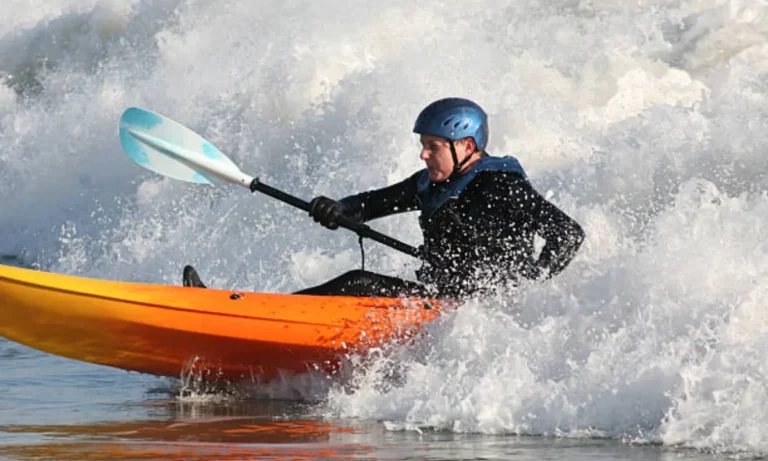Inflatable vs. Hard-Shell Kayak: Which Is Right for You?
Inflatable vs. Hard-Shell Kayak: Explore the differences between these kayak types. Discover which suits your adventure bestInflatable kayaks are easier to transport than hard-shell kayaks. With an inflatable kayak, you can deflate it and fold it up into a small, compact size. This allows you to easily fit it into a car, SUV, or truck without needing roof racks.

You can inflate the kayak when you reach your destination. When deflated, inflatable kayaks are lightweight and easy to carry by hand. Hard-shell kayaks are rigid and bulky. They don’t fold up or deflate. You need roof racks to transport hard-shell kayaks on a vehicle. And they are heavy and awkward to lift onto a roof.
So inflatable kayaks save you the hassle of installing roof racks. And you avoid struggling to get a heavy rigid kayak onto your vehicle. Just deflate and stow the inflatable kayak inside your car.
Buying your first kayak is more complicated than you expected. You have an important decision to make upfront – should you get an inflatable kayak or a hard-shell kayak?
In the past, hard kayaks were the obvious choice. But not anymore!
Modern inflatable kayaks have come a long way. They now offer great benefits that rival traditional hard kayaks. As a beginner buyer, you’ll need to think carefully about inflatable vs hard kayaks. It’s not a straightforward decision.
You can’t just default to a hard kayak like in the old days. Inflatable kayaks are more compelling than ever before. So weigh the pros and cons of inflatables and hard shells. Figure out which is better for your needs as a first-time kayak owner. It’s an important choice to make right off the bat.
Related Article: Kayak Rudder VS Skeg
Inflatable vs. Hard-Shell Kayak: Which Is Right for You?
1. What Are Kayaks Made Of?
Kayaks are boats that you can paddle on the water. There are two kinds of kayaks: hardshell and inflatable. Hardshell kayaks are made from different things like wood, plastic, or strong cloth. They are very heavy, about 55 pounds. Inflatable kayaks are made from rubber and plastic. They are not heavy, only 25 pounds. You can blow air into them to make them bigger.
2. Which Costs More – An Inflatable Kayak or a Hardshell Boat?
Inflatable kayaks are cheaper than hardshell kayaks. More people like inflatable kayaks now because they are stronger.
They have extra air inside them so they don’t get holes or leaks easily. They are more expensive than other inflatable boats because they are made from hard stuff that doesn’t break.
Hard stuff like wood and glass makes hardshell kayaks more expensive. They also need more money and work to fix them when they get damaged.
3. Transportation and Storage
Inflatable kayaks are easy to move. You don’t need a big rack on your car to take them to the water. You can carry them by yourself. Inflatable kayaks can also get smaller when you let the air out. You can put them in a bag or a box. Some inflatable kayaks can even go in a backpack. This is good for people who like to hike and kayak.
When you drive, you can put your inflatable kayak in your car. When you get back, you can keep your kayak in a small place. But you have to dry it first.
Inflatable kayaks are good because you can take them anywhere and keep them easily.
4. Safety in the Water
You want to be safe when you kayak on the water with other people. You also want to follow the rules of boating, especially if you are new to it.
Your kayak should be strong enough for the water you are in. Some waters are very rough, like rivers with rapids. Hardshell kayaks were good for these waters, but some inflatable kayaks are safe now.
Kayak makers have made inflatable kayaks that can go in Class 3 and Class 4 waters. These waters have fast currents. But not all inflatable kayaks can do this. So, ask if the inflatable kayak you want to buy is good for class 3 and class 4 waters.
If you kayak a lot in rivers with rapids, this is important for your kayak choice. Some kayakers may think you need a hardshell boat to go around rocks, but experienced kayakers know that inflatable kayaks can bounce off rocks.
5. Which Kayak Type Can Handle More Weight?
An inflatable kayak can carry a lot of weight in the boat. It can carry more weight than a hardshell kayak. Some inflatable yaks are very light, but they can still hold up to 500 pounds.
This means kayakers can bring more things on the boat–like fishing stuff, hiking stuff, and safety stuff– and they can use more add-ons.
Inflatable Kayaks 101

An inflatable kayak is a kayak made of soft materials like PVC. You need to blow air into it before you use it. You might think:
“Is this just a big toy for the pool?”
But if you give it a chance, you will see that inflatables today are very strong and last a long time. They are like hard kayaks.
How safe are inflatable kayaks? Inflatable kayaks have improved a lot because of new technology and better makers. They can do well and be safe like hard kayaks. You might like inflatable kayaks more than hard kayaks because they are light, small, easy to carry, and cheaper.
Hard Shell Kayaks 101

Hard-shell kayaks are made from solid materials like plastic, fiberglass, or wood. This rigid construction makes them durable but heavier.
The hard shell gives excellent stability and control, especially in rough water. These boats withstand impacts well.
Hard kayaks do cost more than inflatables. But their solid build quality and performance are worth it for some.
They come in many designs – sit-inside, sit-on-top, recreational, touring, etc. So they offer versatility for different uses.
8 Differences Between Inflatable vs. Hard-Shell Kayak You Should Know

Inflatable vs. Hard-Shell Kayak have both improved a lot over time and are now quite comparable in many ways.
However, it’s important to know they’re not the same. When you change how they’re made, it affects other aspects as well, although not entirely.
So, let’s look at the 8 main in Inflatable vs. Hard-Shell Kayak ways boats differ!
Intended Use, Purpose & Water Conditions
You may ask if inflatable kayaks are good for beginners. The answer is yes, they are.
They have air inside them, which makes them float well. They are also light, easy to balance, and cheap. These are good things for new paddlers.
But hard-shell kayaks can also be good for beginners if you choose the right one.
Hard-shell kayaks can do more things and go to more places than inflatable kayaks. They can handle rough water and big waves better. But they are also more expensive.
Materials & Construction
Hard kayaks have an array of construction materials – polyethylene, ABS, fiberglass, carbon fiber, wood, and Kevlar. Each has advantages for performance and durability. Inflatables were once made of basic PVC or nylon that couldn’t compete.
But new high-end inflatables use rigid drop-stitch technology. This lets them inflate to high pressure for a stiff, stable feel. These premium inflatables rival hard shells in quality now. They offer similar rigidity and handling without the heavy weight.
So don’t think inflatables are cheap pool toys anymore. Advanced double-layer drop stitch material and high air pressure give them a sturdy build. Inflatable designs have come a long way. They can keep up with hard kayaks due to innovations in materials and construction.
Don’t underestimate the performance of a high-end inflatable! Stable, durable, yet lighter than a hard shell.
Weight: How Much Do They Weigh?
How heavy a kayak is depends on what it is made of. This is true for both inflatable and hard-shell kayaks.
Some hard shells are lighter than others because they use different materials, sizes, and shapes. But some inflatable kayaks are also heavy. Still, most of the time, inflatable kayaks are lighter than hard-shell kayaks, by about 10 to 20 pounds:
A normal hard-shell kayak for fun is about 40 pounds, but an inflatable kayak is usually 25 to 30 pounds.
Capacity: How Much Can They Hold?
Inflatable kayaks typically have a higher weight capacity than hard kayaks.
Most inflatables can carry around 500 pounds of weight. Hard kayaks usually max out at 300 pounds capacity. So inflatables have an edge for gear-heavy activities like fishing. They offer more cargo space and weight capacity.
Inflatable tandem kayaks are also good for two people since they can support more combined weight. For budget-minded folks or those with limited storage, inflatable fishing kayaks are a great high-capacity choice.
Inflatable kayaks allow you to carry more gear and weight than hard kayaks of the same size. Their increased capacity makes them ideal for fishing and tandem paddling. So if you need to haul a lot of stuff or take a friend, an inflatable kayak will have the advantage in capacity over a hard shell.
Performance: Speed & Maneuverability
Inflatable vs. Hard-Shell Kayaks sit lower in the water for better stability. Their heavier weight also resists rocking in waves. The narrow hull and streamlined shape of a hard shell slice smoothly through the water. It tracks straight with less effort.
Inflatables ride higher up. Their wider, rounder shape takes more work to paddle and steer.
So hard shells glide faster, track truer, and handle better. They’re engineered for speed and nimble moves.
Inflatables can feel sluggish and clumsy by comparison. You’ll need time to adapt to their different feel. While inflatables work fine for casual paddling, hard kayaks excel at performance and maneuverability. Their design makes them more responsive.
So if speed, tracking, and nimble handling matter, hard shells outshine inflatables on overall paddling performance.
Storage & Transportation
Inflatable kayaks are far easier to store and transport than hard shells. It’s a major advantage.
An inflatable folds up small after deflating. Pack it in a bag and take it anywhere easily.
An Inflatable vs. Hard-Shell Kayak stays large and rigid. You need a trailer or roof rack to haul it around. And dedicated space to store it.
Stashing an inflatable is a cinch. But finding room for a bulky hard shell can be tough.
Plus inflatables are lighter than rigid kayaks. One person can carry a deflated inflatable kayak.
When it comes to convenience and portability, inflatables beat out hard shells. Their compact size when deflated makes storage and transport a breeze.
So if you have limited space at home or want to travel with your kayak, an inflatable offers huge advantages. No question, portability goes to the inflatable yak.
Stability
Inflatable kayaks are harder to flip over than hard shells. Their wide beam increases stability.
The wider shape keeps an inflatable kayak upright. It resists tipping side-to-side more than a narrow hard shell.
Multiple air chambers provide backup flotation too. If one leaks, the others keep buoyancy.
Hard kayaks can capsize more easily, especially for beginners. Their narrow hull tips more readily.
So while hard shells may have some performance advantages, inflatables are better for stability.
Their wide, air-filled design makes them far tougher to overturn accidentally. For beginner paddlers, an inflatable kayak’s extra width and buoyancy provide reassurance.
When it comes to staying upright, inflatables win over hard shells thanks to their unwavering stability.
Maintenance
Inflatable vs. Hard-Shell Kayak All kayaks need proper care after use, both inflatables and hard shells. With inflatables, rinse off dirt, drain fully, and let dry before storing. This prevents mold or mildew.
Don’t leave an inflatable pumped up when storing it. That strains seams and valves over time.
Hard shells also need rinsing after saltwater use. Apply wax regularly too for protection.
You may need to repaint a hard kayak occasionally if the finish gets worn or damaged.
Both Inflatable vs. Hard-Shell Kayak require some basic maintenance. Taking proper care makes them last longer. But neither type of kayak is maintenance-free. Expect to put in some work keeping your ‘yak in good shape.
The care is easy though – just rinse, dry, and store properly after use. And your kayak will serve you well for years.
Pros and Cons of Inflatable vs. Hard-Shell Kayak

Inflatable Kayaks – Advantages
Inflatable Kayaks – Disadvantages
Hardshell Kayaks – Advantages
Hardshell Kayaks – Disadvantages
Final Verdict: Inflatable vs. Hard-Shell Kayak What’s Better?

New paddlers or calm water in Inflatable vs. Hard-Shell Kayak? Go inflatable. Inflatables work best for beginners and protected waters. Their stability and buoyancy add confidence. Easy transport is a bonus too.
Limited on space or budget? Inflatable. Compact storage and lower cost make inflatables ideal if you’re short on space or money. Performance and open water your thing? Hard shell.
Hard shells excel at speed, tracking, and control. Whitewater or oceans won’t faze them.
Storage and lifting no problem? Inflatable vs. Hard-Shell Kayak
You’ll need room for a bulky hard kayak. And strength to haul it around. But unmatched performance definitive winner in inflatable vs hard kayaks. Pick based on your paddling needs and situation. Both offer advantages!







Thanks for sharing. I read many of your blog posts, cool, your blog is very good.